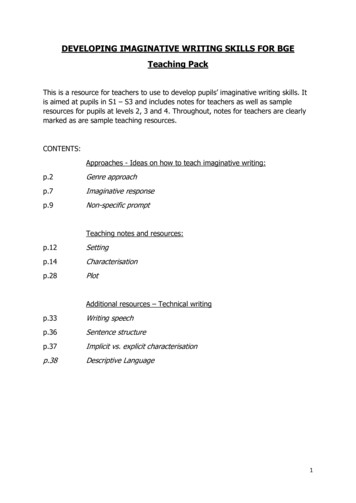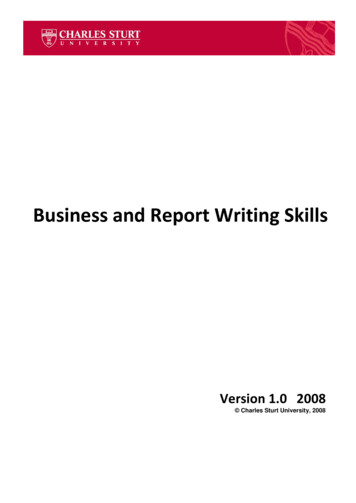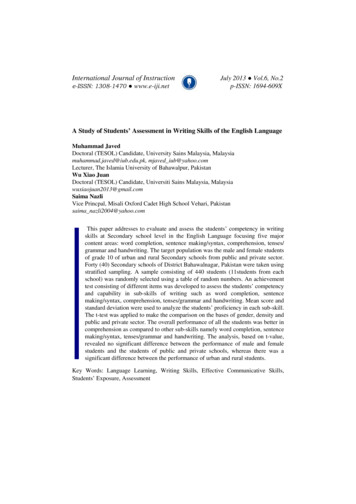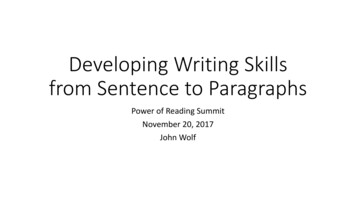
Transcription
DEVELOPING IMAGINATIVE WRITING SKILLS FOR BGETeaching PackThis is a resource for teachers to use to develop pupils’ imaginative writing skills. Itis aimed at pupils in S1 – S3 and includes notes for teachers as well as sampleresources for pupils at levels 2, 3 and 4. Throughout, notes for teachers are clearlymarked as are sample teaching resources.CONTENTS:Approaches - Ideas on how to teach imaginative writing:p.2Genre approachp.7Imaginative responsep.9Non-specific promptTeaching notes and dditional resources – Technical writingp.33Writing speechp.36Sentence structurep.37Implicit vs. explicit characterisationp.38Descriptive Language1
Genre SpecificTEACHER’S NOTES:Genre Specific – Why should I choose this approach?This is another approach you can take to starting a creative writing unit with pupils,as it lends itself to imaginative freedom (creating original characters and setting),while having clearly defined parameters for setting, character archetypes andcommon plot devices.While slightly trickier than an imaginative response writing task, genre-specificwriting will provide an opportunity for pupils to critically examine different texts(from the chosen genre) and identify their common features. Additionally, it willchallenge them to stick, not only to a format, but also a writing style.While listing the pros above, the difficulty one encounters when teaching to a genreis making sure that pupils fully understand the defined parameters of that genre:common settings, character types and examples of plots/themes encountered. Thisseems easily explained within a few lessons, however, when discussing themes orplot structures, it can become overwhelming for pupils. They are either confused bythe multiple different directions that their plot could go in, they fill their stories witharchetypal characters, or they directly copy other source material.TEACHING IDEAS:Initial Lessons – Establishing GenreWhen approaching genre, especially sci-fi or horror, it is important to establish whatpupils associate with the genre to establish their pre-existing knowledge. I wouldalways start a unit by establishing the bigger picture by letting pupils know that theymust produce a writing piece (this could be a short story or a journal entry) thatfulfils the chosen genre markers. During this initial lesson, I would also encourageyou to introduce them to any special/technical vocabulary with definitions that theymay need in order to write their story.This could be a starter task, where pupils are shown images from movies,illustrations or photographs associated with the genre (eg. Horror could be classicimages from Dracula, Frankenstein, or modern horror films) and are asked to notedown descriptive words, feelings and objects that they associate with the genre.2
Example 1:Look at this place:What do you think has happened here?Why do you think it happened?This place is an example of a ‘dystopia’. What do youthink a dystopia is?A utopia is the exact opposite of a dystopia.What is a utopia?(2 mins to come up with some answers!)If you wanted this to translate to a longer task, this could involve something like filmtrailers, which are particularly accessible to pupils who are not familiar with literaryexamples of the chosen genre. To scaffold this task, you could provide a worksheetwith a table where pupils must comment on the setting and the characters. For Level4, or higher ability pupils, you could include section that allows them to comment ontheme/emotion.Regardless of the format, any introductory lesson should allow pupils to build uponbase knowledge of the genre, provide them with basic definitions of genre markersand introduce them to a brief overview of setting, character, and theme.Intermediate Lessons – Establishing Genre TropesFollowing on from the initial lesson, you should begin to cover setting, character,and themes/plot with pupils. These lessons should both serve as a basic introductionto the concept of each element and show how these elements are used within thechosen genre. Prioritise the element that is most important to writing this genre, thiscould be setting for a genre like fantasy or plot devices for detective fiction. Spendmore than one lesson on it if need be, as this will ensure that pupils have a throughunderstanding of at least one aspect of the genre and, therefore, their final outcomewill be more appropriate.3
Setting Activities1. Establish common elements of the genre setting. Where are the storiesnormally set? What time period is appropriate? What is the social setting?What is the mood or atmosphere? What could different settings look like?Give examples of a specific setting, model a description of this and get pupilsto write a short paragraph describing it from a first-person perspective.2. Analyse examples of setting in genre texts. This is useful as it builds closereading skills and will help with writing openings as the setting is often one ofthe first things established.3. Give them a prompt (eg. A character – where would this person live?) andask pupils to create their own setting.4. A carousel activity where pupils are given a setting and they writeassociations that they have with that place (eg. Descriptive words, events,characters, tropes). Sensory descriptive activities are also very useful.Once the genre setting has been fully established, provide a checklist for setting withvarious genre specific options. This could be tick box and will help pupils of alower ability create a good setting for their story – include type, atmosphere, theMC’s location and any themes that they might include in their story. If teaching aLevel 2 class, for example, it would be useful to select the setting yourself to avoidany confusion. Furthermore, assure eager pupils that the sheet is merely a guideand that they can choose their own setting if they wish. This will be useful for pupilswhen they write their story as they can continually refer back to it.Character Activities1. Introduce the basic needs that a character has – appearance, personality,background, occupation, strengths, weaknesses, goals etc. More on this inthe “character” section.2. Establish character archetypes with examples from popular film/literature tohelp illustrate your example. List their main traits and behaviours below sothat pupils can understand WHAT characteristics these archetypes have. Forfantasy this could be the hero, the wise mentor, the damsel-in-distress, andthe joker/ally. Try not to complicate things too much, stick to two-characterarchetypes for their own stories, with others merely as an example.3. Pupils could “fill-in-the-blanks” with these characters based on appearance.4. Reading passages from relevant texts and then ask the pupils to describe thepersonality of the character (helps close reading skills and they can grasp theidea of implicit meaning).4
Once the concept of character is grasped, provide a character worksheet with spaceto draw a character and fill in their character worksheets. It is also helpful to createyour own character as a model for pupils. Below is a basic example that could bereworked for any genre.ExampleCharacter Profile:Character’s Appearance:Name:Age:Personality ly/Relationships:Arch Enemy:5
Plot Activities1. Introduce pupils to a basic 3-arc plot structure (Level 2). Additionally, youcould cover different methods of story telling: journal written retrospectively,newspaper reports, flashbacks, beginning in medias res, beginning at the end(Level 3 and 4).2. Make sure you use an example, perhaps from a text previously studied withthe class or a well known story. Get the pupils to identify the exposition,conflict, climax and resolution to make sure that they understand the plotstructure.Finally, provide them with a plot sheet where they can fill in elements of their plotbefore they write. An extension task could also include story boarding their plot.TEACHER’S NOTESBefore they writeThis advice is applicable to any type of creative writing approach.Make sure that you cover the technical aspects of writing, such as using effectivelanguage (using examples from earlier lessons on setting or character can beuseful); using sentence structure to enhance; writing speech; correct punctuationactivities.Provide pupils who are lower ability with word banks (genre specific descriptivewords), sentence starters (even some cloze sections if need be), body languageexamples, punctuation examples, and reminders of sentence types.Make sure any necessary notes that pupils made on character, setting and plot areavailable to them while they write – this will assist them if they get some writer’sblock and keep them on track.6
Imaginative responseTEACHER’S NOTES:Imaginative response – Why should I choose this approach?This could be a fun task to ease pupils into more independent imaginative writing. Itcould be set as a task during (or at the end) of reading of a novel, play, short story,or after studying a group of poems. This can work as a perfect springboard fordeveloping imaginative writing skills, without the learner having to start completelyfrom scratch. It can also crossover with functional writing.TEACHING IDEAS:A letter from a character: Once reaching a certain part of a text, a task could beplanned whereby a main character has to write a letter (or an email) to someone.This is best planned where the letter is to someone that is not already in the story,so that the pupil has to demonstrate that they have understood what has happenedin the plot, as well as demonstrating understanding of character and setting.Another idea, if you are studying war poetry, is to get pupils to imagine that they area soldier at the front and to write a letter home to a loved one.Teaching Tips: Provide pupils with an example of a letter format.Give sentence starters as options to use.Give outline of the subject matter of each paragraph (e.g first paragraph,explain what has been happening, second paragraph explain how thecharacter is feeling, third paragraph, predict what will happen next).Show, don’t tell. Spend some time teaching implicit and explicit descriptions.Diary entry:Like a letter, this could be a good task to do during reading a longer text or if youare studying war poetry, you can get pupils to write a diary entry about what it islike being at the front.TIPS: Show examples of famous diaries and highlight language features.Give breakdown of what they can write in each paragraph.Do a mind map to plan, with sections on character, plot and setting.Drama:If studying a play, you can ask pupils to write a scene with the existing characters.7
Teach pupils how to write dialogue (see p. for example)Use a page or two of the play to highlight the feature of writing drama (e.g.how to write stage directions and layout of characters speech).Establish aims: Suggested word count- Level 2 (100 – 200 words)- Level 3 (200 - 500 words)- Level 4 (500 – 700 words)Format- Always display an example of the format, letter, diary entryetc.Differentiation: Must/should/could- Give different word limit options- Give example starter lines as an option to use8
Non- specific promptTEACHER’S NOTES:Non-specific prompt – Why should I choose this approach?There are many different ways to approach a creative writing unit. One way that isoften talked about but is not immediately accessible is the non-specific promptapproach. The non-specific prompt approach is when you are given an object, titleor any other “non-specific” thing that gives you a start for your creative piece. It is“non-specific” because it gives you a choice as to how you bring it into your writing.One way to do this as a teacher is to look at the levels you are teaching and whatyour students should be getting out of this task. I would often say that creativewriting is a very open task where levels are more accessible as all of the writingcomes from one’s self. However, if you were struggling with levels for this task youcould break it down so that if your class were set as level 2 you would create thestart of the story for them and see where they want to take it, this would be ascaffolding technique, so that you were modelling a standard for them that they canfollow. If you were teaching a set level 3 class you could give them a title to seewhat they would take from that and to motivate creativity. However, if you wereteaching a level four class bringing an object that is “non-specific” into the story is aanother way in which learners can start to create their own individual styles andresponses to stimuli.TEACHING IDEASNon-specific prompt types:Story starter:The overarching shadows seemed to reach for me, as I walked on towards that eeriebuilding. The darkness drawing me in as I arrive at the door. A shiver runs down myspine as I push down the handle and step inside [This type of prompt creates a setting, stage or platform from which learners canmove the story on.]Titles for your work:The Ghost ShipThe PiratesThe AccidentThe PortalThe SurpriseThe DescendantBefore TomorrowA PromiseA Dream Come True9
For this to work the class must understand what the words in the title connotes. Thiscan be part of the planning stage or followed as a model for class discussiondisplaying whole class ideas. This is useful for learners to take initiate but also forlearners who struggle to fabricate somewhere to go within the story. This can becovered in the section regarding plot but as we know plot is the makeup of what iscreated by your characters and your setting.Object Prompt:This is an approach that I think can be so much fun for the creative process. Itinvolves bringing in a random object into the class and making it a focus or at least apart of the writing process. Ways to do this can be by passing the object around firstand asking for adjectives to describe it or ideas as to where you would find it. This isuseful as it helps to familiarise learners with said objects and to make links with itbetween both different times and spaces in which the object would appear. Thereare many different objects you can use such as; a medal, a map, a watch or evensomething as mundane as a pencil. The important part of this task is that they startto create an idea around the time or the situation in which this object wasimportant.It is also important to realise that many classes will not be set and you can have anarray of ability that you are working with and working for. This is when I wouldsuggest using the must, should and could format for differentiating the task. Thissimply means that you pick one of the above methods and break it down across allthe following levels: level 2 is for your must, level 3 is for your should and level 4 isfor your could groups. This is for your marking schemes as well as for the tasksheets you will give out for each level.Must – This will be aimed at level 2 and will follow an almost fill in the blanksapproach so that for anyone who struggles to fabricate the links between thedifferent parts of the story there is an outline to follow. This should still allow forcreative choices in the blanks.Should – This will be aimed at level 3 and will do the same as the must but only fortwo paragraphs so that the creative process is modelled for them before they beginto model their own.Could – This will be aimed at level 4 and will be very much an open task for them. Iwould suggest giving paragraphs headings for them to follow such as; setting,character, conflict, climax and resolution.What is stated above would link to the benchmarks for creative writing and shouldbe specifically set with the task you have created in mind.10
However to arrive at this point of writing for such a story, you must have coveredmany different aspects of writing such as; plot, character and setting. All of thesemust be understood individually to bring together a cohesive story.11
Teaching notes and resourcesSettingSetting can be defined as the “place or type of surroundings where something ispositioned or where an event takes place”Useful Definitions:Time: This is When the story takes placePlace: This is the location where the story is setWords commonly associated with setting are mood and atmosphere. Anunderstanding of these two things will help you to create a setting.[I would recommend asking the following question to help bridge anygaps in understanding.]1. What sort of emotion is the setting trying to convey?Top Tip:Both mood and atmosphere are used to convey the feeling ofa story. If students can tell what feeling is created it meansthey can start to see the markers that led them to thisunderstanding.Different Tasks1. A way you can help your learners start to see the link between the above is togive them a list of locations and time periods and ask them to match them tothe different pictures shown on the board. This should familiarise them withwhat fits together. You can take this step further by asking them how theycould tell what went with what and why this was? You can also ask themwhat mood they associate with each picture. This is another way to breakdown the task via the must, should and could format.2. Another task to help further understanding of setting is to display a set ofwords under a picture and ask the class to create their own adjectives. Thisshould further an understanding of what a setting feels like and how they canshow this through language.12
3. When it comes to setting the senses are what is important as theycommunicate something about where we are. The five senses; sight, smell,taste, touch and hearing are vital to creating a viable setting in a story.Creative writing is supposed to take us somewhere different and believable. Atask that I think is useful for this is one that will actively bring the senses intoour use of language. I would create a task where groups would be asked todescribe the following; how an object looked, the smell of a flower, the feel ofa fabric, the voice of someone they care about and what chocolate tastes like.This would be achieved as a carousel activity before it became a whole classdiscussion to show that we all respond differently to things which is whycreative writing is so much fun as it is completely our own. It is also is a greatopportunity to share adjectives and to further our vocabulary as a class.Technical Aspects of Creative Writing:-MetaphorsSimilesPersonificationAll of these are important as theytell us more about a setting.They liken it to something whichdisplays a feeling towards it.Metaphor: a figure of speech in which a word or phrase is applied to an object oraction to which it is not literally applicable.Simile: a figure of speech involving the comparison of one thing with another thingof a different kind, used to make a description more emphatic or vivid (e.g. as braveas a lion)Personification: the attribution of human characteristics to an object or setting.All of the above create more belief in the mood and atmosphere of a setting.Task: You can show the class different extracts of writing that focus on setting andask them to pick out the language or parts of the writing that create a believableworld through mood and atmosphere. This is really interesting because you can pullsections from specific genres and talk about how the setting creates a feeling forwhat the story is about as a whole. It is interesting to choose extracts from differentgenres to show this contrast more clearly. This means that learners understandmore fully the process of creating a setting and in what way it sets up the model forthe story.Task: Creating sentences which contain aspects of metaphorical language andasking the students to find them and tell you what they suggest is another usefultask in creating a move towards a writing piece. From here students can make up13
their own sentences and create answers as to what they are suggesting about atime, place or object. They will swap with another student and see if they can judgethe feeling of the sentence.This is all a part of a modelling process. See below a process of planning:Place (General Location):Things we would find inthe location:Time (year):Time of day:How does this linkwith the place(think feeling andatmosphere):Weather:Think about yoursenses (what arethey telling orshowing youabout this place)Metaphors, Similesor Personificationyou could use:14
Teaching notes and resourcesCharacterisation[Teacher’s notes are in [ ] and in bold throughout, everything else isintended as resource for pupils to use]What do you think we mean by characterisation? Characterisation means creating characters. This involves two separateprocesses. First, you get to know your character (s) and, secondly, you selectinformation to communicate to your readers.One of the first things that a writer does to tell us about a character is todescribe them.TASK 1:[Teacher’s note: Task 1 is aimed at both Level 2 and 3, and can beadapted for Level 4 to include character descriptions of a text that isbeing read in class]Task 1: The Secret Garden - CharactersHere is an example of a character being described.MRS MEDLOCK: HousekeeperShe was a stout woman, with very redcheeks and sharp black eyes. She wore avery purple dress, a black silk mantle withjet fringe on it and a black bonnet withpurple velvet flowers which stuck up andtrembled when she moved her head.15
PUPIL TASK: Read the description of the two characters and then draw apicture of the character in the box. Try to include all of the descriptions that thewriter gives us.MARY LENNOX: Young girlWhen Mary Lennox was sent to Misselthwaite Manor to live with her uncle everybodysaid she was the most disagreeable looking child ever seen. It was true, too. Shehad a little thin face and a little thin body, thin light hair and a sour expression. Herhair was yellow, and her face was yellow because she had been born in India andhad always been ill in one way or another.Draw Mary in this box.16
DICKON:He was a funny looking boy about twelve. He looked very clean and his nose turnedup and his cheeks were as red as poppies and never had Mistress Mary seen suchround and such blue eyes in any boy’s face.Draw Dickon in this box17
Creating your own character[Teacher note: Level 2, Level 3 and Level 4 are all separate worksheets, colour coded][Level 2]You are going to write a description for your own character.Things to think about 1. What does your character look like?Are they short, tall? What is their hair colour? Describe their facial features.2. What do they wear, and how do they wear it?What a character wears and how they wear it can tell us a lot.“Andy wore a smart suit with the shirt buttoned right to the top.”“Debbie wore a baggy jumper with a scarf slung over her shoulder.”What do these descriptions tell us about these people. What type of peopledo you think they are from these descriptions?3. What kind of sounds do they make?Can you describe their voices, their footsteps, their verbal mannerisms?“Mrs Wilson had a shrill laugh and a high-pitched voice that made hersound like a bird chirping.”4. How do they smell – pleasant, unpleasant, natural or artificial?“Jacob smelled like firewood and fresh air, which suggested that heworked outside.”TASK 2:[Teacher note: see also ‘character profile’ sheet on p.5 which can be usedto build character description]1. Get a good picture of your character into your head before you begin writing.You may not use all the details you have decided on, but your character willbe more realistic if you have given him / her careful consideration. Try toinclude at least one description from points 1 – 4 above.18
Write a paragraph to describe your character.2. Now, swap your worksheet with a partner. Draw a picture in the box belowusing your partner’s description.Draw a picture using the character description.3. Does their drawing look like how you have imagined your character?19
Remember, the reader can’t see inside yourhead and read your thoughts. You have todescribe in words the picture that you see inyour own head. If the drawing is not like howyou imagined your character, think about whatyou have missed out. Could you use moredescription so that the reader has an accuratepicture?20
LEVEL 3Creating your own characterYou are going to write a description for your own character.Things to think about 1. What does your character look like?Are they short, tall? What is their hair colour? Describe their facial features.2. What do they wear, and how do they wear it?What a character wears and how they wear it can tell us a lot.“Andy wore a smart suit with the shirt buttoned right to the top”.“Debbie wore a baggy jumper with a scarf slung over her shoulder”.What do these descriptions tell us about these people. What type of peopledo you think they are from these descriptions?3. What kind of sounds do they make?Can you describe their voices, their footsteps, their verbal mannerisms?“Mrs Wilson had a shrill laugh and a high-pitched voice that made hersound like a bird chirping.”4. How do they smell – pleasant, unpleasant, natural or artificial?“Jacob smelled like firewood and fresh air, which suggested that heworked outside.”5. Taste and touch can also be used.Do they grab or claw? Do they savour each morsel when they eat?“Katie snatched the cake out of the boys hand and devoured it in onebite.”What do these actions suggest about Katie?6. Name your character.Remember, names come with associations. They may suggest the character isold-fashioned, exotic, aristocratic, babied or despised. You can choose nameswhich are affectionate diminutives or associated with screen or pop stars. Butwhatever names you choose, think about the associations first.21
TASK 2:[Teacher note: see also ‘character profile’ sheet on p.5 which can be usedto build character description]1. Get a good picture of your character into your head before you begin writing.You may not use all the details you have decided on, but your character willbe more realistic if you have given him / her careful consideration. Try toinclude at least one description from points 1 – 6 above.Unusual details can be most evocative, so use your senses.Write a paragraph to describe your character.2. Now, swap your worksheet with your partner. Draw a picture in the boxbelow using your partners description.Draw a picture using the character description:22
Does their drawing look like how you have imagined your character?Remember, the reader can’t see inside yourhead and read your thoughts. You have todescribe in words the picture that you see inyour own head. If the drawing is not like howyou imagined your character, think about whatyou have missed out. Could you use moredescription so that the reader has an accuratepicture?23
LEVEL 4Creating your own characterYou are going to write a description for your own character.Things to think about 1. What does your character look like?Are they short, tall? What is their hair colour? Describe their facial features.2. What do they wear, and how do they wear it?What a character wears and how they wear it can tell us a lot.“Andy wore a smart suit with the shirt buttoned right to the top”.“Debbie wore a baggy jumper with a scarf slung over her shoulder”.What do these descriptions tell us about these people. What type of peopledo you think they are from these descriptions?3. What kind of sounds do they make?Can you describe their voices, their footsteps, their verbal mannerisms?“Mrs Wilson had a shrill laugh and a high-pitched voice that made hersound like a bird chirping.”4. How do they smell – pleasant, unpleasant, natural or artificial?“Jacob smelled like firewood and fresh air, which suggested that heworked outside.”5. Taste and touch can also be used.Do they grab or claw? Do they savour each morsel when they eat?“Katie snatched the cake out of the boys hand and devoured it in onebite.”What do these actions suggest about Katie?6. Name your character.Remember, names come with associations. They may suggest the character isold-fashioned, exotic, aristocratic, babied or despised. You can choose nameswhich are affectionate diminutives or associated with screen or pop stars. Butwhatever names you choose, think about the associations first.24
TASK 2:[Teacher note: see also ‘character profile’ sheet on p.5 which can be usedto build character description]1. Get a good picture of your character into your head before you begin writing.You may not use all the details you have decided on, but your character willbe more realistic if you have given him / her careful consideration. Try toinclude at least one description from points 1 – 6 above.Unusual details can be most evocative, so use your senses.Write a paragraph to describe your character.2. Now, swap your worksheet with your partner. Draw a picture in the boxbelow using your partners description.Draw a picture using the character description:25
Does their drawing look like how you have imagined your character?Remember, the reader can’t see inside yourhead and read your thoughts. You have todescribe in words the picture that you see inyour own head. If the drawing is not like howyou imagined your character, think about whatyou have missed out. Could you use moredescription so that the reader has an accuratepicture?Level 4 extended task:Going forward with your character writing: Characterisation and plot are connected.Characters will be more effective if they are shown to be doing something at aspecific time and place in your story. Your characters should also change or developduring the narrative – only cardboard cut-outs are untouched by the course ofevents. Don’t forget the past.What has happened to make your characters the way they are? How do they feelabout themselves? How do they interact with others? What is the driving force intheir lives? Really know your charac
DEVELOPING IMAGINATIVE WRITING SKILLS FOR BGE . Frankenstein, or modern horror films) and are asked to note down descriptive words, feelings and objects that they associate with the genre. 3 . to write a short paragraph describing it from a first-person pe










